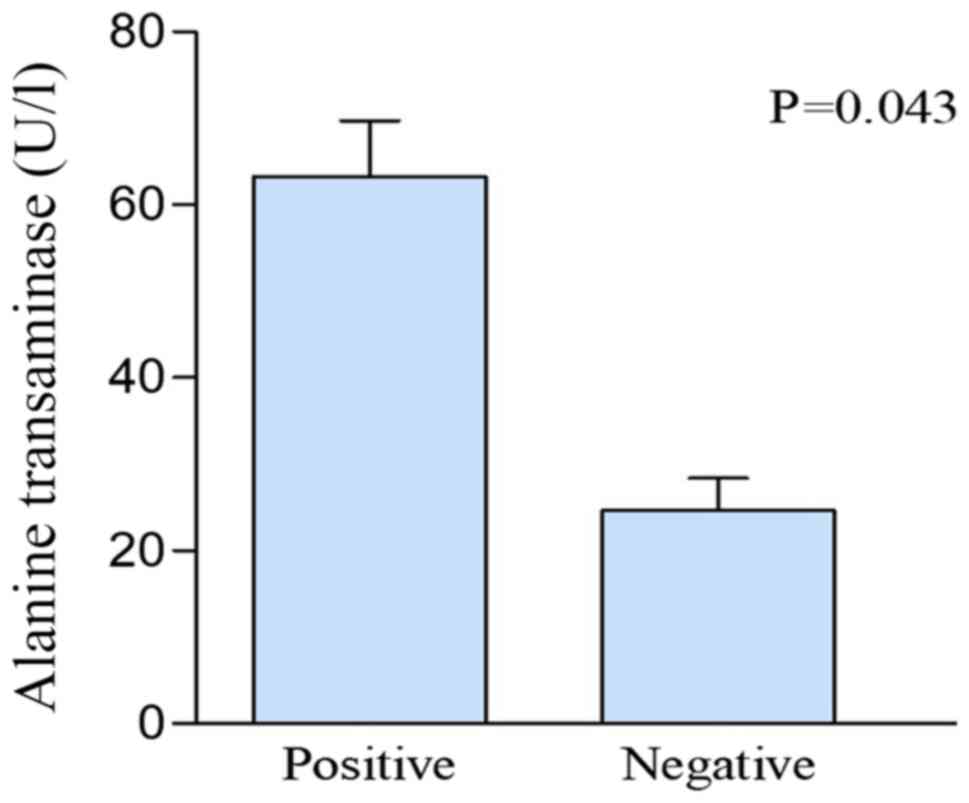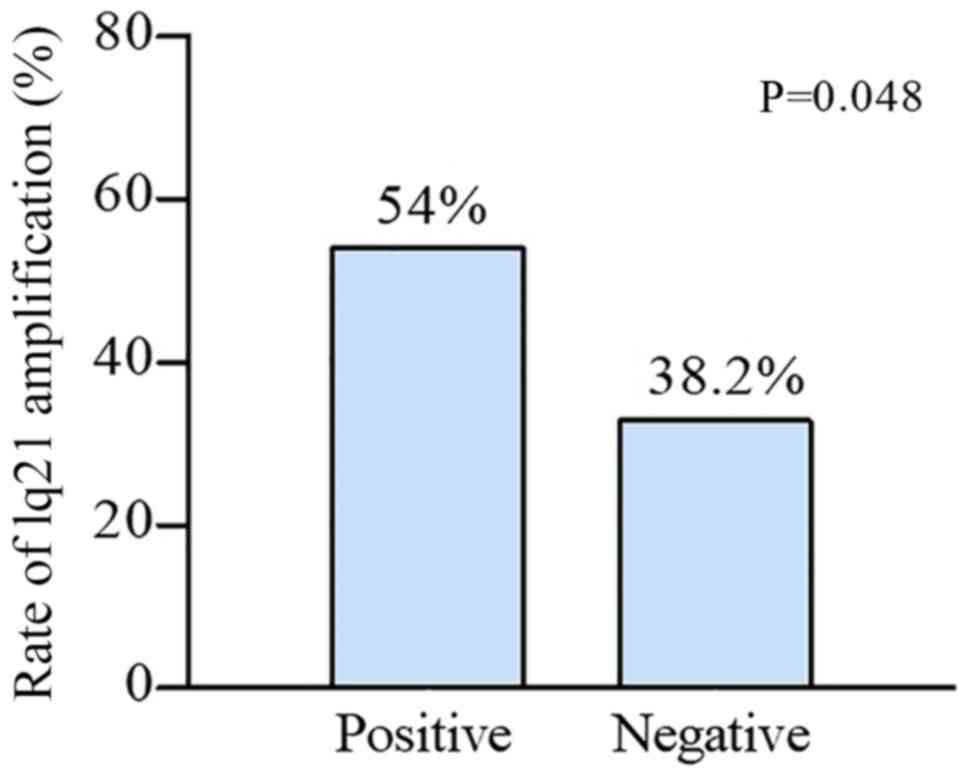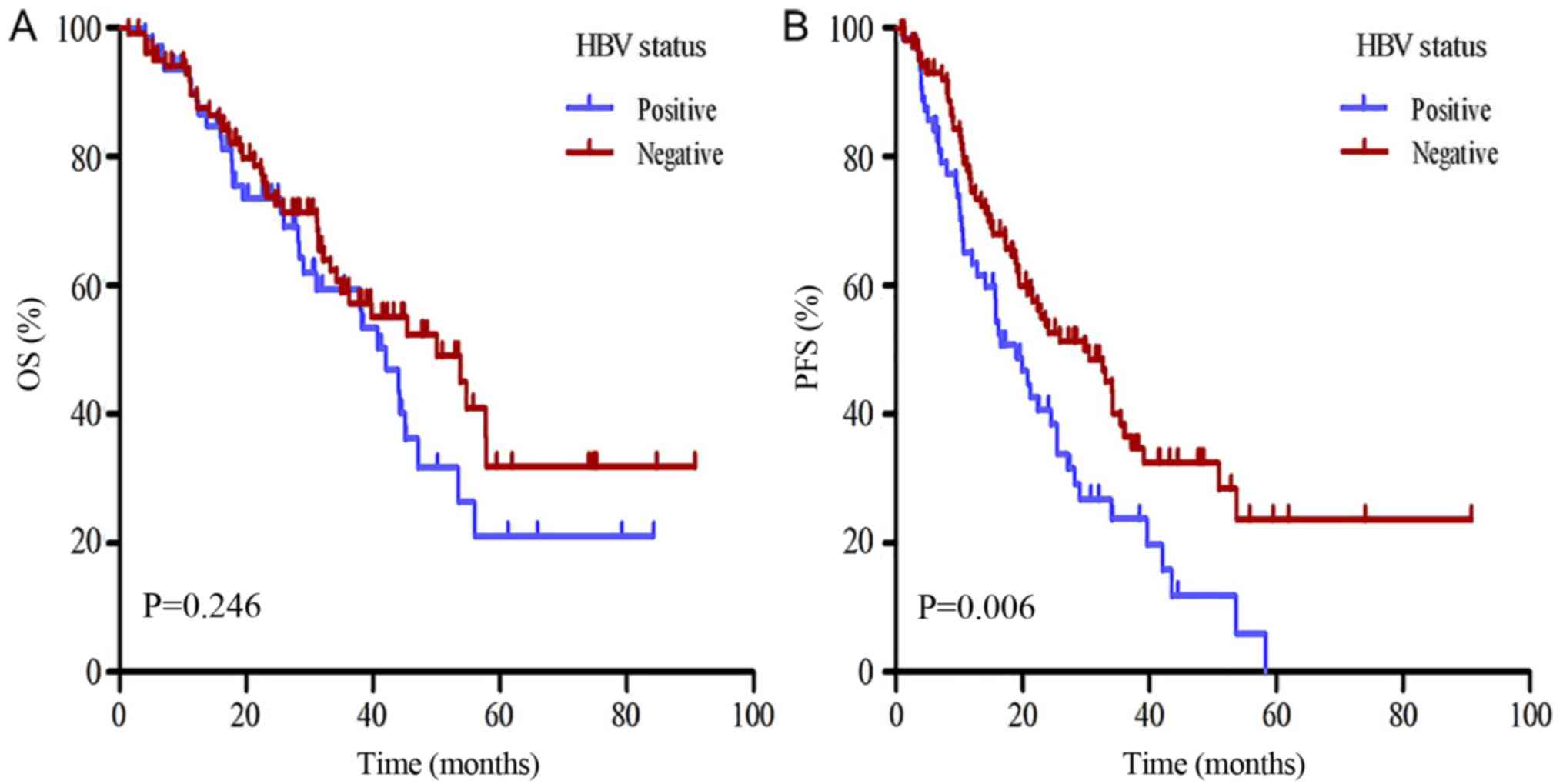|
1
|
Li J, Liu J, Huang B, Zheng D, Chen M,
Zhou Z, Xu D and Zou W: Hepatitis B virus infection status is an
independent risk factor for multiple myeloma patients after
autologous hematopoietic stem cell transplantation. Tumour Biol.
34:1723–1728. 2013. View Article : Google Scholar : PubMed/NCBI
|
|
2
|
Noonan CA, Yoffe B, Mansell PW, Melnick JL
and Hollinger FB: Extrachromosomal sequences of hepatitis B virus
DNA in peripheral blood mononuclear cells of acquired immune
deficiency syndrome patients. Proc Natl Acad Sci USA. 83:5698–5702.
1986. View Article : Google Scholar : PubMed/NCBI
|
|
3
|
Marcucci F and Mele A: Hepatitis viruses
and non-Hodgkin lymphoma: Epidemiology, mechanisms of
tumorigenesis, and therapeutic opportunities. Blood. 117:1792–1798.
2011. View Article : Google Scholar : PubMed/NCBI
|
|
4
|
Smith L, McCourt O, Henrich M, Paton B,
Yong K, Wardle J and Fisher A: Multiple myeloma and physical
activity: A scoping review. BMJ Open. 5:e0095762015. View Article : Google Scholar : PubMed/NCBI
|
|
5
|
Avet-Loiseau H, Bahlis NJ, Chng WJ, Masszi
T, Viterbo L, Pour L, Ganly P, Palumbo A, Cavo M, Langer C, et al:
Ixazomib significantly prolongs progression-free survival in
high-risk relapsed/refractory myeloma patients. Blood.
130:2610–2618. 2017. View Article : Google Scholar : PubMed/NCBI
|
|
6
|
Becker N, Schnitzler P, Boffetta P,
Brennan P, Foretova L, Maynadié M, Nieters A, Staines A, Benavente
Y, Cocco P and de Sanjose S: Hepatitis B virus infection and risk
of lymphoma: Results of a serological analysis within the European
case-control study Epilymph. J Cancer Res Clin Oncol.
138:1993–2001. 2012. View Article : Google Scholar : PubMed/NCBI
|
|
7
|
Teng CJ, Liu HT, Liu CY, Hsih CH, Pai JT,
Gau JP, Liu JH, Chiou TJ, Hsu HC, Chen PM, et al: Chronic hepatitis
virus infection in patients with multiple myeloma: Clinical
characteristics and outcomes. Clinics (Sao Paulo). 66:2055–2061.
2011. View Article : Google Scholar : PubMed/NCBI
|
|
8
|
Rajkumar SV, Dimopoulos MA, Palumbo A,
Blade J, Merlini G, Mateos MV, Kumar S, Hillengass J, Kastritis E,
Richardson P, et al: International Myeloma Working Group updated
criteria for the diagnosis of multiple myeloma. Lancet Oncol.
15:e538–e548. 2014. View Article : Google Scholar : PubMed/NCBI
|
|
9
|
Durie BG and Salmon SE: A clinical staging
system for multiple myeloma. Correlation of measured myeloma cell
mass with presenting clinical features, response to treatment, and
survival. Cancer. 36:842–854. 1975. View Article : Google Scholar : PubMed/NCBI
|
|
10
|
Greipp PR, San Miguel J, Durie BG, Crowley
JJ, Barlogie B, Bladé J, Boccadoro M, Child JA, Avet-Loiseau H,
Kyle RA, et al: International staging system for multiple myeloma.
J Clin Oncol. 23:3412–3420. 2005. View Article : Google Scholar : PubMed/NCBI
|
|
11
|
Palumbo A, Avet-Loiseau H, Oliva S,
Lokhorst HM, Goldschmidt H, Rosinol L, Richardson P, Caltagirone S,
Lahuerta JJ, Facon T, et al: Revised international staging system
for multiple myeloma: A report from international Myeloma Working
Group. J Clin Oncol. 33:2863–2869. 2015. View Article : Google Scholar : PubMed/NCBI
|
|
12
|
Kumar S, Paiva B, Anderson KC, Durie B,
Landgren O, Moreau P, Munshi N, Lonial S, Bladé J, Mateos MV, et
al: International Myeloma Working Group consensus criteria for
response and minimal residual disease assessment in multiple
myeloma. Lancet Oncol. 17:e328–e346. 2016. View Article : Google Scholar : PubMed/NCBI
|
|
13
|
Huang H and Chen J: Chromosome bandings.
Methods Mol Biol. 1541:59–66. 2017. View Article : Google Scholar : PubMed/NCBI
|
|
14
|
Simons A, Shaffer LG and Hastings RJ:
Cytogenetic nomenclature: Changes in the ISCN 2013 compared to the
2009 edition. Cytogenet Genome Res. 141:1–6. 2013. View Article : Google Scholar : PubMed/NCBI
|
|
15
|
Li GP, Liu Y, White KL and Bunch TD:
Cytogenetic analysis of diploidy in cloned bovine embryos using an
improved air-dry karyotyping method. Theriogenology. 63:2434–2444.
2005. View Article : Google Scholar : PubMed/NCBI
|
|
16
|
Katzel JA, Hari P and Vesole DH: Multiple
myeloma: Charging toward a bright future. CA Cancer J Clin.
57:301–318. 2007. View Article : Google Scholar : PubMed/NCBI
|
|
17
|
Lin CL and Kao JH: Natural history of
acute and chronic hepatitis B: The role of HBV genotypes and
mutants. Best Pract Res Clin Gastroenterol. 31:249–255. 2017.
View Article : Google Scholar : PubMed/NCBI
|
|
18
|
Michalak TI: Occult persistence and
lymphotropism of hepadnaviral infection: Insights from the
woodchuck viral hepatitis model. Immunol Rev. 174:98–111. 2000.
View Article : Google Scholar : PubMed/NCBI
|
|
19
|
Sinha M, Rao CR, Premalata CS, Shafiulla
M, Lakshmaiah KC, Jacob LA, Babu GK, Viveka BK, Appaji L and
Subramanyam JR: Plasma Epstein-Barr virus and Hepatitis B virus in
non-Hodgkin lymphomas: Two lymphotropic, potentially oncogenic,
latently occurring DNA viruses. Indian J Med Paediatr Oncol.
37:146–151. 2016. View Article : Google Scholar : PubMed/NCBI
|
|
20
|
Huang B, Li J, Zhou Z, Zheng D, Liu J and
Chen M: High prevalence of hepatitis B virus infection in multiple
myeloma. Leuk Lymphoma. 53:270–274. 2012. View Article : Google Scholar : PubMed/NCBI
|
|
21
|
Chen CJ, Wang LY and Yu MW: Epidemiology
of hepatitis B virus infection in the Asia-Pacific region. J
Gastroenterol Hepatol. 15 (Suppl):E3–E6. 2000. View Article : Google Scholar : PubMed/NCBI
|
|
22
|
Stasi C, Silvestri C and Voller F:
Emerging trends in epidemiology of hepatitis B virus infection. J
Clin Transl Hepatol. 5:272–276. 2017. View Article : Google Scholar : PubMed/NCBI
|
|
23
|
Rehermann B, Ferrari C, Pasquinelli C and
Chisari FV: The hepatitis B virus persists for decades after
patients' recovery from acute viral hepatitis despite active
maintenance of a cytotoxic T-lymphocyte response. Nat Med.
2:1104–1108. 1996. View Article : Google Scholar : PubMed/NCBI
|
|
24
|
Moinzadeh P, Breuhahn K, Stützer H and
Schirmacher P: Chromosome alterations in human hepatocellular
carcinomas correlate with aetiology and histological grade-results
of an explorative CGH meta-analysis. Br J Cancer. 92:935–941. 2005.
View Article : Google Scholar : PubMed/NCBI
|
|
25
|
Becker N, Byl A, Friedrich S, Jauch A,
Schnitzler P, Egerer G, Ho AD, Goldschmidt H and Neben K: Hepatitis
B virus infection is associated with deletion of chromosome 8p in
multiple myeloma. Eur J Haematol. 90:279–285. 2013. View Article : Google Scholar : PubMed/NCBI
|
|
26
|
Chen L, Chan TH and Guan XY: Chromosome
1q21 amplification and oncogenes in hepatocellular carcinoma. Acta
Pharmacol Sin. 31:1165–1171. 2010. View Article : Google Scholar : PubMed/NCBI
|
|
27
|
Willis TG, Zalcberg IR, Coignet LJ,
Wlodarska I, Stul M, Jadayel DM, Bastard C, Treleaven JG, Catovsky
D, Silva ML and Dyer MJ: Molecular cloning of translocation
t(1;14)(q21;q32) defines a novel gene (BCL9) at chromosome 1q21.
Blood. 91:1873–1881. 1998.PubMed/NCBI
|
|
28
|
Oh IS and Park SH: Immune-mediated liver
injury in hepatitis B virus infection. Immune Netw. 15:191–198.
2015. View Article : Google Scholar : PubMed/NCBI
|
|
29
|
Bang SM, Kim SS, Park SH, Ahn JY, Cho EK,
Shin DB and Lee JH: Acute exacerbation of chronic hepatitis B
during thalidomide therapy for multiple myeloma: A case report.
Korean J Intern Med. 19:196–198. 2004. View Article : Google Scholar : PubMed/NCBI
|
|
30
|
Lee JY, Lim SH, Lee MY, Kim H, Sinn DH,
Gwak GY, Choi MS, Lee JH, Jung CW, Jang JH, et al: Hepatitis B
reactivation in multiple myeloma patients with resolved hepatitis B
undergoing chemotherapy. Liver Int. 35:2363–2369. 2015. View Article : Google Scholar : PubMed/NCBI
|
|
31
|
Li J, Huang B, Li Y, Zheng D, Zhou Z and
Liu J: Hepatitis B virus reactivation in patients with multiple
myeloma receiving bortezomib-containing regimens followed by
autologous stem cell transplant. Leuk Lymphoma. 56:1710–1717. 2015.
View Article : Google Scholar : PubMed/NCBI
|
|
32
|
Dimopoulos MA, Barlogie B, Smith TL and
Alexanian R: High serum lactate dehydrogenase level as a marker for
drug resistance and short survival in multiple myeloma. Ann Intern
Med. 115:931–935. 1991. View Article : Google Scholar : PubMed/NCBI
|
|
33
|
Maillet D, Montiel-Cervantes L,
Padilla-González Y, Sánchez-Cortés E, Xolotl-Castillo M, Vela-Ojed
J and Reyes-Maldonado E: Serum calcium is an independent prognostic
factor of overall survival in Mexican patients with multiple
myeloma. Rev Invest Clin. 64:17–24. 2012.PubMed/NCBI
|
|
34
|
Li H, Wu K, Tao K, Chen L, Zheng Q, Lu X,
Liu J, Shi L, Liu C, Wang G and Zou W: Tim-3/galectin-9 signaling
pathway mediates T-cell dysfunction and predicts poor prognosis in
patients with hepatitis B virus-associated hepatocellular
carcinoma. Hepatology. 56:1342–1351. 2012. View Article : Google Scholar : PubMed/NCBI
|

















